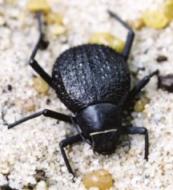- More than 2 years ago
A desert-dwelling beetle is inspiring engineers to create surfaces with an uncanny ability to collect water from fog.

Christian Dorrer and Jürgen Rühe of the University of Freiburg in Germany created a surface that attracts fog’s microscopic water droplets, encouraging them to condense. Once the droplets get too large, the surface lets them slip away so they can be collected. The work was published online May 20 in Langmuir.
A mass-produced version of the invention could be useful in remote areas that lack access to drinking water. Depending on the amount of fog, a few square meters of the surface might collect enough water for one person every day, Dorrer says — although he cautions that no studies exist to make that estimate precise. The technology could also help scrub pollutant mists in industrial smokestacks.
In developing the new material, the researchers took a hint from a beetle of the Stenocara genus, which lives in southwestern Africa’s Namib Desert and draws on fog as its sole source of water (SN 11/17/01, p 312). Stenocaras’ backs are water-repellent surfaces with a pattern of microscopic, water-loving patches. The bugs collect water by doing a headstand and letting droplets flow toward their mouth.
In their approach, Dorrer and Rühe first created a carpet of silicon spikes, each about a micrometer thin, and coated it with a highly water-repellent organic material. A droplet of water will sit on such a surface like a fakir on a bed of nails, Dorrer says, keeping an almost spherical, beadlike shape. The droplet will also slip away if the surface is tilted even slightly.
The researchers then painted a polka dot pattern on top of the surface, this time using a water-loving material. Water droplets from fog, which can be as small as 10 nanometers across, will tend to stick to the water-loving dots (and merge with one another). Meanwhile, droplets that condense on the water-repellent areas will tend to drift down, until they run across a water-loving region and merge with other droplets.
“The droplets grow and grow,” Dorrer says, until their size exceeds that of the dot they’re sitting on. They then become free to flow downward.
Michael Rubner of MIT and his team created similar water-collecting surfaces by a different technique in 2006.
Ray H. Baughman, a materials scientist at the University of Texas at Dallas, says that to maximize the surface’s efficiency at collecting water it may be worthwhile to try arranging the water-loving dots randomly, or perhaps in a fractal pattern, rather than like polka dots.






